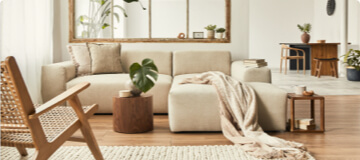Bamboo flooring is fast emerging as one of the most popular flooring products on the market. With all of the beautiful elegance of natural timber floors, bamboo flooring is in an aesthetic league of its own. But the advantages do not end there. Bamboo flooring is also incredibly durable and it is, even more, water resistant than conventional hardwood timbers.
The best part: bamboo flooring is very affordable. However, as with all flooring products, you can only get the most out of your bamboo flooring if you treat it well. This means regular cleaning and care. But what exactly does that entail? There are many things you can do to keep your bamboo flooring at its best. To help out, we have compiled a short list of a few great tips.
1. Be wary of scratching bamboo flooring: place felt pads on the base of your furniture
As with all natural timber flooring, bamboo is susceptible to scratching. Some things have a particular tendency for generating scratches. Probably the most common cause of scratched bamboo flooring is furniture. As the feet of your chairs, couches, cabinets and desks move around a bamboo floor, they almost invariably leave scratches in their wake.
This is something that all homeowners with timber floors experience at some point. Don’t worry though; there is an easy solution. Simply purchase small adhesive felt pads and apply them to the parts of your furniture that come into contact with the floor. These pads are very effective and inexpensive. You can find them at homewares and hardware stores alike.
2. Don’t let water pool on your bamboo flooring
Bamboo flooring has a remarkable natural quality that most timber floors lack: it is somewhat water resistant. A combination of its unique grain and fine finishes allow bamboo to repel water in small quantities. However, this does not make it completely waterproof. If you allow spilt liquids to pool on your floor for a long period of time, they will probably soak in.
This can have a number of effects. In the worst cases, the water soaks into the bamboo floor. As a result, the flooring then swells in the affected areas. Due to the tight tessellation of your floorboards, this will cause them to warp out of shape and possible split. Fortunately, that is easily avoided by simply wiping up spilt liquids promptly.
3. Vacuum your bamboo floors frequently
Small particles of dirt, dust, or sand have an abrasive effect on all floors. This means that as you walk over the particles on your floor, they gradually abrade the protective outer layers of the bamboo. If your floor is consistently dusty or gritty, it can have much the same effect as fine sandpaper. Vacuuming and sweeping regularly removed these particles and prevents unnecessary damage to your bamboo floor.
4. Avoid using steam to clean them
As most homeowners would understand, there is no better feeling than having a thoroughly cleaned house. For homeowners with carpet or even tile floors, this might mean using a steam mop, or steam cleaner. But when it comes to timber floors, steam cleaners of any variety are inappropriate. In the same way that spilt liquids can soak into the bamboo, so too can steam. If this happens, you might find yourself in a similar situation, where the floorboards swell and warp. Instead, you can simply use a damp microfiber mop to give your bamboo flooring a sparkling sheen.
5. Only use appropriate cleaning products
There is an abundance of floor cleaning products available. Most specify their intended applications on the bottle. These range from carpet cleaners, to floor polishes and everything in between. To avoid using an abrasive or acidic product, you should only use floor cleaners that are well suited to timber. These are often pH neutral and strictly non-abrasive.
For all your flooring and carpet needs on the Gold Coast, contact the experts at Ashmore Carpets today on (07) 5526 8611.





